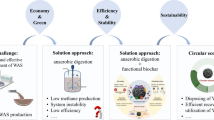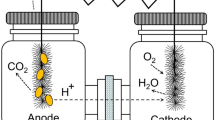Abstract
A hybrid airlift reactor was adopted to retain aerobic granules in the reactor successfully for continuous operation. It was found that aerobic granules maintained excellent physical structure stability in the continuous-flow reactor with reactor performance as good as batch operation. However, flocs appeared after batch operation was switched to continuous operation, and chemical oxygen demand (COD) in the wastewater was thus removed by co-existed granules and flocs in the reactor. Furthermore, excessive precipitation of CaCO3 as needled shaped aragonite in the continuous aerobic granular sludge reactor was observed, which led to the further enhancement of settling ability of granules with sludge volume index (SVI) reduction from 32 to 2 ml g−1 but specific oxygen utilization rate (SOUR) decrease from 61 to 23 mg O2 g−1 MLVSS h−1. Thus, apart from the physical structure stability, bioactivity stability of granules should be also considered as an important parameter to evaluate the continuous operation of aerobic granular sludge. Furthermore, the decrease in granule polysaccharide content implied that protein was more important for aragonite precipitation. The excessive aragonite precipitation in the continuous-flow reactor could be due to the competition between flocs and granules. In addition, the degradation of polysaccharide in aerobic granules under a continuous-flow mode may also contribute to excessive aragonite precipitation.







Similar content being viewed by others
References
Adav SS, Lee DJ, Tay JH (2007) Extracellular polymeric substances and structural stability of aerobic granule. Water Res 42:1644–1650
APHA (1998) Standard methods for the examination of water and wastewater, 19th edn. American Public Health Association, Washington
Bradford MM (1976) A rapid and sensitive method for the quantitation of microgram quantities of protein utilizing the principle of protein-dye binding reproduction. Anal Biochem 72:248–254
Council Directive 91/271/EEC (1991) http://eur-lex.europa.eu/legal-content/EN/TXT/PDF/?uri=CELEX:31991L0271&from=EN
Dubois M, Gilles KA, Hamilton JK, Rebers PA, Smith F (1956) Calorimetric method for determination of sugar and related substances. Anal Chem 28:350–356
Dupraz CR, Reid P, Braissant O, Decho AW, Norman RS, Visscher PT (2009) Processes of carbonate precipitation in modern microbial mats. Earth Sci Rev 96:141–162
Feng QL, Pu G, Pei Y, Cui FZ, Li HD, Kim TN (2000) Polymorph and morphology of calcium carbonate crystals induced by proteins extracted from mollusk shell. J Cryst Growth 216:459–465
Jia XS, Furumai H, Fang HHP (1996) Yields of biomass and extracellular polymers in four anaerobic sludges. Environ Technol 17:283–291
Juang YC, Adav SS, Lee DJ, Tay JH (2010) Stable aerobic granules for continuous-flow reactors: precipitating calcium and iron salts in granular interiors. Bioresour Technol 101:8051–8057
Kawaguchi T, Decho AW (2002) A laboratory investigation of cyanobacterial extracellular polymeric secretions (EPS) in influencing CaCO3 polymorphism. J Cryst Growth 240:230–235
Kong YH, Liu YQ, Tay JH, Wong FS, Zhu JR (2009) Aerobic granulation in sequencing batch reactors with different reactor height/diameter ratios. Enzym Microb Technol 45:379–383
Kong Q, Ngo HH, Shu L, Fu RS, Jiang CH, Miao MS (2014) Enhancement of aerobic granulation by zero-valent iron in sequencing batch airlift reactor. J Hazard Mater 279:511–517
Li J, Cai A, Wang M, Ding L, Ni Y (2014) Aerobic granulation in a modified oxidation ditch with an adjustable volume intraclarifier. Bioresour Technol 157:351–354
Liu YQ, Tay JH (2007) Cultivation of aerobic granules in a bubble column and an airlift reactor with divided draft tubes at low aeration rate. Biochem Eng J 34:1–7
Liu YQ, Moy B, Kong YH, Tay JH (2010) Formation, physical characteristics and microbial community structure of aerobic granules in a pilot-scale sequencing batch reactor for real wastewater treatment. Enzym Microb Technol 46:520–525
Liu YQ, Kong Y, Tay JH, Zhu J (2011) Enhancement of start-up of pilot-scale granular SBR fed with real wastewater. Sep Purif Technol 82:190–196
Liu H, Li Y, Yang C, Pu W, He L, Bo F (2012) Stable aerobic granules in continuous-flow bioreactor with self-forming dynamic membrane. Bioresour Technol 121:111–118
Mishima K, Nakamura M (1991) Self-immobilization of aerobic activated sludge. A pilot study of the aerobic upflow sludge blanket process in municipal sewage treatment. Water Sci Technol 23:981–990
Morales N, Figueroa M, Mosquera-Corral A, Campos JL, Mendez R (2012) Aerobic granular-type biomass development in a continuous stirred tank reactor. Sep Purif Technol 89:199–205
Morgenroth E, Sherden T, van Loosdrecht MCM, Heijnen JJ, Wilderer PA (1997) Aerobic granular sludge in a sequencing batch reactor. Water Res 31:3191–3194
Ni M, Ratner BD (2008) Differentiating calcium carbonate polymorphs by surface analysis techniques—an XPS and TOF-SIMS study surface and interface analysis. Surf Interface Anal 40:1356–1361
Qin L, Liu Y, Tay JH (2004) Effect of settling time on aerobic granulation in sequencing batch reactor. Biochem Eng J 21:47–52
Stocks-Fischer S, Galinat JK, Bang SS (1999) Microbiological precipitation of CaCO3. Soil Biol Biochem 31:1563–1571
Tay JH, Liu QS, Liu Y (2001) Microscopic observation of aerobic granulation in sequential aerobic sludge blanket reactor. J Appl Microbiol 91:168–175
Thaveesri J, Daffonchio D, Liessens B, Verstraete W (1995) Different types of sludge granules in UASB reactors treating acidified wastewaters. Int J Gen Mol Microbiol 68:329–337
Tsuneda S, Nagano T, Hoshino T, Ejiri Y, Noda N, Hirata A (2003) Characterization of nitrifying granules produced in an aerobic upflow fluidized bed reactor. Water Res 37:4965–4973
van Langerak EPA, Gonzalez-Gil G, van Aelst A, van Lier JB, Hamelers HVM, Lettinga G (1998) Effects of high calcium concentrations on the development of methanogenic sludge in upflow anaerobic sludge bed (UASB) reactors. Water Res 32:1255–1263
Wada N, Okazaki M, Tachibana S (1993) Effects of calcium binding polysaccharides from calcareous algae on calcium carbonate polymorphs under conditions of double diffusion. J Cryst Growth 132:115–121
Zhou D, Liu M, Gao L, Shao C, Yu J (2013) Calcium accumulation characterization in the aerobic granules cultivated in a continuous-flow airlift bioreactor. Biotechnol Lett 35:871–877
Compliance with ethical standards
ᅟ
Conflict of interest
The authors declare that they have no competing interests.
Ethical approval
This article does not contain any studies with human participants or animals performed by any of the authors.
Author information
Authors and Affiliations
Corresponding author
Rights and permissions
About this article
Cite this article
Liu, YQ., Lan, GH. & Zeng, P. Excessive precipitation of CaCO3 as aragonite in a continuous aerobic granular sludge reactor. Appl Microbiol Biotechnol 99, 8225–8234 (2015). https://doi.org/10.1007/s00253-015-6727-6
Received:
Revised:
Accepted:
Published:
Issue Date:
DOI: https://doi.org/10.1007/s00253-015-6727-6




